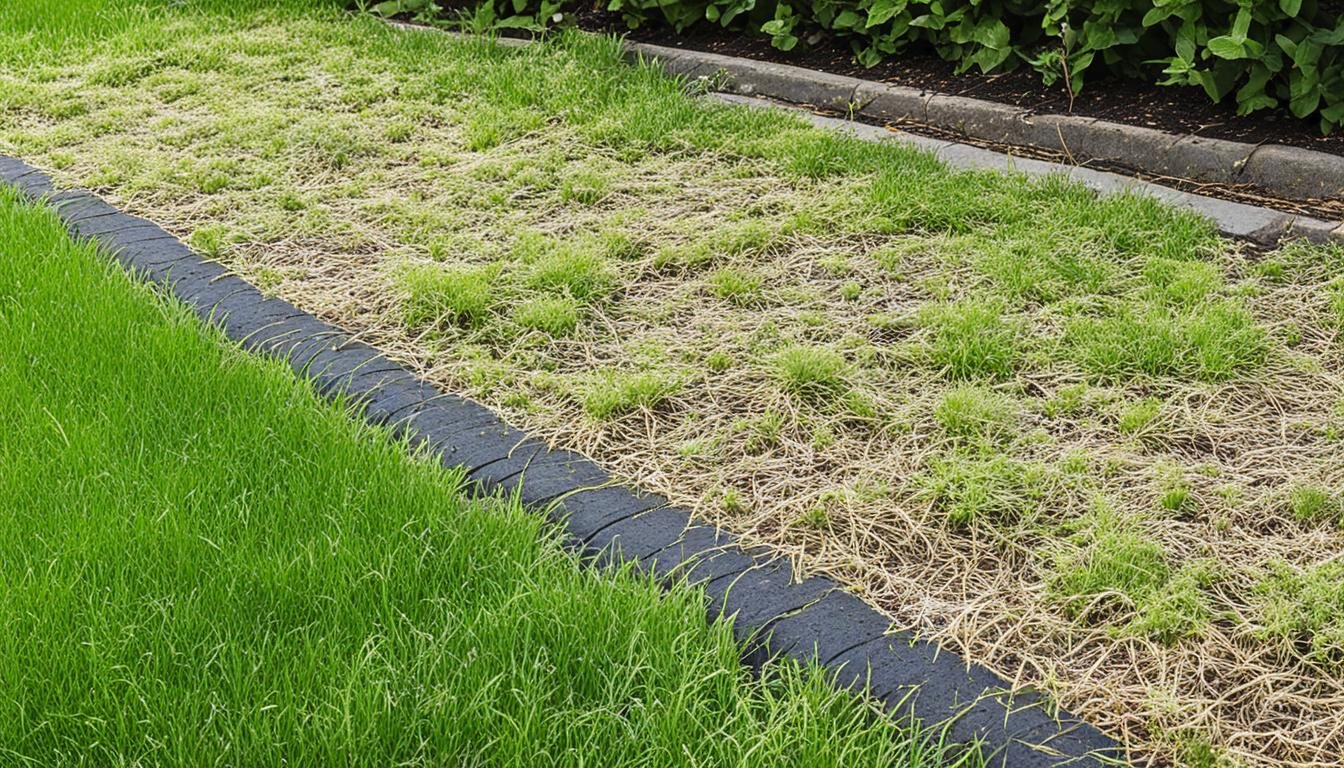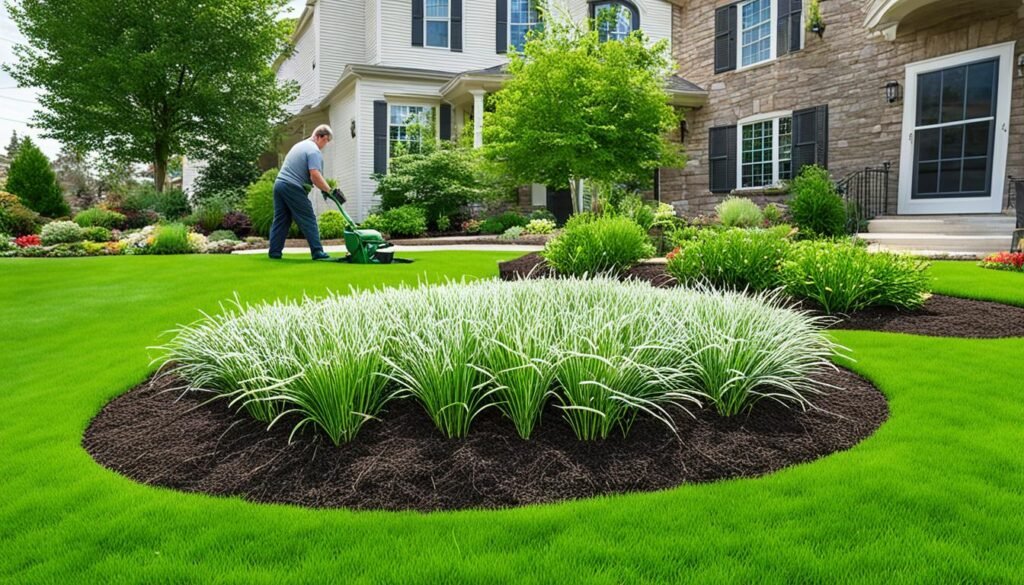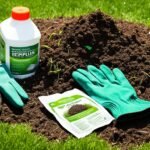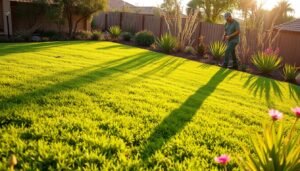
Did you know that a damaged lawn can bring down the value of your property by up to 15%? Neglected lawns with dead or patchy grass can create a negative first impression and discourage potential buyers or visitors. But don’t worry, there’s hope! With the right approach and professional guidance, you can revive your damaged lawn and transform it into a lush, vibrant space that enhances the beauty of your home. In this article, we will explore expert strategies for damaged lawn care, including lawn repair services, restoration, and renovation.
Key Takeaways:
- Reviving a damaged lawn can significantly increase the value of your property.
- Professional damaged lawn care services can help you transform your lackluster lawn into a vibrant and healthy oasis.
- Implementing the right strategies, such as lawn restoration and renovation, can revive dead or patchy grass.
- Neglected lawns can create a negative first impression and deter potential buyers or visitors.
- Investing in your lawn’s care can provide long-term benefits and enhance the overall beauty of your home.
How to Determine if Your Lawn is Dead or Dormant
When faced with a brown lawn, it’s important to determine whether the grass is dead or just dormant. The first step is to perform a tug test by pulling on a few brown grass leaves. If the grass resists and doesn’t pull out easily, it is likely dormant. Another way to determine lawn dormancy is by considering the grass type and local weather. Cool-season grasses often go dormant during the summer, while warm-season grasses go dormant during the winter. By understanding these factors, you can determine if your brown lawn is a result of dormancy or if the grass is truly dead.
| Distinguishing factors between dead grass and dormant grass | Dead Grass | Dormant Grass |
|---|---|---|
| Response to Tug Test | Grass pulls out easily | Grass resists and doesn’t pull out easily |
| Grass Color | Entirely brown or yellow | Patches of brown with some green |
| Growth and Recovery | No signs of regrowth | Grass regrows when weather conditions improve |
| Grass Type | May vary, but typically includes warm-season grasses in regions with harsh winters | May vary, but typically includes cool-season grasses in regions with hot summers |
Remember: If your grass is dormant, it’s in a state of temporary rest and will recover once favorable conditions return. However, if it’s dead, you may need to take additional steps to revive your lawn.

“Understanding the difference between dead grass and dormant grass is crucial for effective lawn care.” – John Smith, Lawn Care Specialist
Strategies for Reviving Dead Grass
Once you have determined that your grass is dead, there are several strategies you can employ to revive it. Testing your soil is an essential step to determine if pH imbalances or nutrient deficiencies are contributing to the dead grass. Dethatching and aerating can help improve the soil conditions and allow for better nutrient absorption. Overseeding with new grass seed can help fill in bare areas and promote new growth. Proper watering, mowing, fertilizing, and weed and pest control are also crucial for the revival of dead grass. By following these strategies, you can give your lawn the care it needs to recover and thrive.
The Importance of Soil Testing
Before implementing any lawn revival strategies, it’s important to test your soil. Soil testing helps you understand the specific needs of your lawn and identify any nutrient deficiencies or imbalances that may be inhibiting grass growth. pH imbalances, for example, can prevent the uptake of essential nutrients by the grass roots. By addressing these issues, you can create optimal soil conditions for grass revival.
Dethatching and Aeration
Excessive thatch – a layer of dead grass, stems, and debris that accumulate on the soil surface – can hinder water and nutrient penetration to the grass roots. Dethatching, using a specialized rake or dethatching machine, removes this layer, allowing for better air and water movement in the soil. Aeration, on the other hand, involves creating small holes in the soil to alleviate compaction and improve nutrient absorption. Both these practices help create a favorable environment for grass revival.
Overseeding for New Growth
Overseeding is the process of spreading new grass seed over existing turf to fill in bare spots and promote new growth. Before overseeding, it’s important to prepare the soil by loosening it and removing any debris or weeds. Once the soil is ready, spread the grass seed evenly and water it thoroughly. Regular watering and proper maintenance will encourage the new grass to establish and revitalize the lawn.
Proper Watering, Mowing, Fertilizing, and Weed/Pest Control
Watering your lawn consistently and deeply is crucial for grass revival. Aim to provide about 1 inch of water per week, either through rainfall or irrigation. Mowing at the correct height and frequency promotes healthier grass growth and discourages weed infestation. Fertilizing with the appropriate nutrients helps nourish the grass and stimulate growth. Lastly, regular weed and pest control measures, such as using herbicides and insecticides, prevent unwanted competition and damage to the revitalizing grass.

Conclusion
Restoring a damaged lawn requires time, effort, and expert knowledge. However, with the right strategies and care, you can revitalize your turf and achieve a lush, healthy lawn. Whether your lawn has been affected by drought, neglect, or other environmental factors, there are solutions available to bring it back to life.
One option to consider is consulting with local landscaping professionals who specialize in damaged lawn care. Companies like Local Landscaping Pros have the expertise and experience to assess the condition of your lawn and provide tailored solutions to address the damage. They can offer services such as soil testing, dethatching, aeration, overseeding, and weed and pest control.
By following the steps outlined in this article and seeking assistance from local landscaping pros, you can transform your damaged lawn into a thriving and beautiful outdoor space. No matter the extent of the damage, don’t give up on your lawn. With the right care and attention, you can restore its health and enjoy the benefits of a lush, green lawn for years to come.






No comment yet, add your voice below!